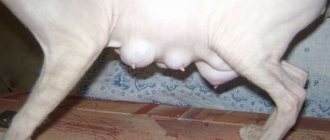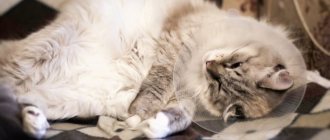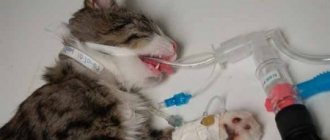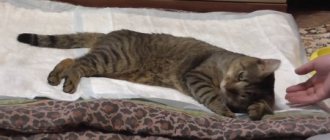The sterilization (castration) operation is only half the battle (see types of cat sterilization, pros and cons). The most important period is the postoperative period, which falls on the shoulders of the cat owner. The veterinarian who performed the operation must provide instructions on all the intricacies of caring for the animal after anesthesia, tell and show how to handle sutures and what to pay attention to when emergency situations arise.
Why preoperative preparation is important
Before the operation, the pet must be prepared. She is vaccinated within a month, and treated against worms within 1.5 weeks. The last feeding is carried out no later than half a day. Water is allowed only 3 hours before the procedure.
This preparation helps to avoid situations that weaken the immune system and eliminate vomiting, which can lead to aspiration pneumonia. Before administering anesthesia, veterinarians check the animal's heart rate and lung function and weigh it. This is necessary to calculate a safe dosage of anesthesia.
Types of cat sterilization
Caring for your cat after surgery depends on the type of sterilization and anesthesia. To eliminate reproductive function, 3 methods are used:
- Tube sterilization
. The animal's fallopian tubes are ligated. This prevents further reproduction, but preserves sexual desire and estrus. The method is used less and less, as it retains the risk of inflammation and oncology of the genital organs.
- Ovariotomy
. The surgeon removes the ovaries but leaves the uterus. The operated patient stops estrus, but the risk of uterine disease remains.
- Ovariohysterectomy
. The safest and most effective method, which involves the removal of all internal genital organs. The risk of developing cancer is completely eliminated.
The operation itself takes less than an hour.
The rest of the time is spent recovering from anesthesia. There are 3 options for waking up:
- Immediately after the anesthesia is turned off. Characteristic of gas anesthesia, which puts the patient into a sedative state. Despite its low toxicity, it is used only in a limited number of veterinary clinics due to a lack of equipment and medicinal substances.
- Within 8 hours. A combination of epidural anesthesia and muscle relaxants. It is also low-toxic, but requires a lot of experience from the surgeon. An error when working with an animal's spine can lead to loss of sensitivity in its paws for up to 2 days.
- Within 5-24 hours. The most common method is the use of analgesics and muscle relaxants. This type of anesthesia is the most severe, so the pet can recover from it for almost the whole day.
Under general anesthesia, the animal's reproductive organs are removed using a scalpel or endoscopic equipment and stitches are placed. Caring for them depends on their type.
How many days does it take for a cat to fully recover?
It is quite difficult to give an exact answer to this question. How many days this process will take the animal depends on several factors (and their combination, of course):
- Pet's age. The younger the better. Accordingly, older cats recover from the effects of surgery much, much longer. So, if “young” cats, even after abdominal surgery, fully come to their senses after about 10-14 days, then for an old cat this period may well last for a month, or even two. Moreover, we would not recommend surgery at all for animals aged seven years and older (this does not apply to cases of sterilization for medical reasons), since the disadvantages of the operation may outweigh its advantages.
- Physiological state of the cat before sterilization. If the animal is severely weakened (after a long and serious illness, for example), it can be operated on only after its complete recovery plus two weeks from this period. In this case, rehabilitation increases to approximately three weeks.
- Power characteristics. If before the operation the animal ate poorly, then the duration of the rehabilitation period will be much longer than if its owners had taken care of a high-quality and balanced diet in advance. Sometimes such cats take a month to recover.
- Breed of the cat. Purebred animals are a special case. Firstly, it is generally recommended to sterilize Persians and British cats when they are at least eight months old, and ideally not earlier than a year (their bodies mature slowly). Secondly, such pets usually recover from the consequences of surgical intervention for quite a long time, about twice as long as if we were talking about mongrel cats. Sometimes - more than a month. There is nothing you can do about this, you just need to remember this nuance.
Important! Full recovery of a cat after sterilization is not a very fast process, and it is incorrect to talk about a “complete” recovery of a pet “by eye.” This period varies for each animal, sometimes significantly.
The first day after surgery
After surgery, the pet can be left in the hospital or taken home immediately. In the second case, it is necessary to understand all possible nuances, since responsibility for the health of the furry patient falls on the owner. Also, the most popular option for sterilization at home remains.
Hospital
Most veterinary clinics offer to leave the animal in their hospital during recovery. This eliminates the need for independent manipulation and guarantees emergency assistance if complications arise.
The disadvantages of this option include the high price and psychological factor. If a pet is strongly attached to its owner, then it will be difficult for her to be left alone in an unfamiliar place. In addition to stress, she may harbor resentment, which will change her behavior forever. There is also always the risk of unscrupulous personnel. You won’t be able to track their work, so it’s safer to trust yourself.
Delivering a cat home
If you decide to take care of your pet at home, prepare for it a warm blanket, disposable diapers and a comfortable carrier. Sometimes a veterinarian will hand a furry patient over to her owners after she regains consciousness. He also needs to make sure the bleeding stops.
After receiving your pet from the doctor’s hands, place her on her right side in a carrier with diapers and cover her with a blanket. This position reduces the load on the heart and prevents vomit from entering the trachea if the cat suddenly feels nauseous. And this happens often after anesthesia.
Coming out of anesthesia
After returning home, place the pet on a soft bedding located on the floor and warm it with a heating pad. Anesthesia disrupts natural thermoregulation and coordination. Without your help, the animal may freeze or get injured if it gets up from an uncomfortable place.
Also make sure you have diapers. Before complete awakening, involuntary bowel and bladder emptying is possible.
If you took your pet without waiting for her to wake up, then you will have to take care of moisturizing her eyes. Animals under anesthesia often have their eyes open but cannot blink them. Because of this, the mucous membranes dry out and become injured. For hydration, you will need to periodically close the cat's eyelids or hydrate the cornea with "artificial tears."
After awakening, attempts to escape are possible in order to hide in an inaccessible place. This occurs due to a lack of coordination and lack of understanding of the events taking place. Try to calm your pet down with affection and conversation. On the first day, keep an eye on her to help if necessary.
Is it possible to feed and water a cat?
Eliminate feeding for one day, but do not forget to give the animal water immediately after waking up. To be safe, use a syringe and watch your swallowing movements. In their absence, your pet may choke.
On the second day, offer food, but no more than ⅓ of the usual portion. By this time, the pet will begin to drink on its own. Interest in food appears on the second or third day. Increase the number of servings gradually, offering low-fat and easily digestible dishes.
It happens that a cat demonstrates severe hunger already in the evening of the first day of surgery. Then you can give her some low-fat broth. Dairy products and solid food should not be given - the animal is likely to vomit.
What you will need
Even before the procedure, take care of a place for rehabilitation and special protection to prevent the suture from tearing. Also, be sure to consult with your doctor about treatments for the incision and medications needed in case of complications.
Blanket, bandage or collar
Until the wound on the abdomen heals, you will have to wear a special cotton blanket with ties at the back. Due to discomfort, the animal will walk unusually or refuse to move at all. After removing the blanket, mobility returns to normal.
An Elizabethan collar is recommended as additional protection. It will prevent you from removing the bandage and licking your wounds on your own.
Even if the female was operated on laparoscopically, she will have a small stitch on her side. Some cats do without a bandage and collar, since they do not lick the seam, while others will need the entire arsenal of protection against licking.
Medicines
All medications are prescribed individually. They are usually necessary for elderly or debilitated patients. If there is no disorder and you feel stable, taking antibiotics, painkillers and vitamins is not required.
Seam treatment products
Caring for the suture left after sterilizing a cat takes 7-10 days. To process it you will need cotton pads or a thick bandage. Ordinary cotton wool can get stuck in the wound and cause suppuration. Chlorhexidine 0.05%, healing sprays and Levomekol ointment will also be useful.
Place for rehabilitation
Prepare in advance a soft, horizontal place away from open windows and heating appliances. Shade the room with curtains and make sure the room temperature is at least 22°C. A heating pad or light blanket is suitable for additional heating.
Nursing pets will have to be temporarily separated from the litter. While feeding, kittens can injure the wound. It is also recommended to avoid contact with children or other pets that could accidentally harm the operated cat.
Blanket for cats from improvised means
It is quite possible to make a blanket with your own hands. This often does not require special cutting and sewing skills. The thing is that it is quite possible to make a bandage from scrap materials. Below we will look at the main options suitable for owners who are not at ease with tailoring skills.
Advice! Regardless of the type of homemade blanket, there is one proven, reliable remedy that prevents the bandage from becoming contaminated with ichor and other wound secretions. We are talking about ordinary... sanitary pads (without flavoring additives). They can easily be slipped under a blanket. In addition, the gaskets are just as easily and quickly replaced with new ones.
Please note that hygiene products should be changed every day. In addition, it is recommended to carry out air baths daily, freeing the cat's stomach from the blanket. This approach promotes rapid healing of the postoperative wound.
Pantyhose blanket
A tights bandage is the simplest option that does not require any special resources. Please note that you should not use “stale” tights: after all, the postoperative area requires complete sterility.
It is also worth looking for a product with increased density: such a “cover” will fit the cat’s body more tightly. In addition, a blanket made of thick tights will simply last longer.
It’s very simple to make: cut a piece of tights 20 centimeters long and pull it over the cat’s belly. In general, that's all. The technique has its pros and cons.
pros
- Any breeder can handle making such a blanket; you don’t need to sew anything.
- Many people have tights; there will be no need to spend extra money.
- There is no need to adjust anything to fit, no ties or other “fasteners” are needed.
- Tights are quite elastic and soft, and therefore many cats quickly get used to them, and therefore do not try to take off unusual clothes every few minutes.
Minuses
- Tights cannot be properly secured to a cat’s body; they will inevitably slide down and curl up.
- If the animal has at least some claws (and they probably do), it only needs to scratch itself a couple of times for your entire structure to immediately be torn to shreds.
- When your pet is young and compact in size, tights may not fit tightly around her belly. This problem can be partly solved by selecting a product with a higher density.
- In addition, nylon gets dirty quickly, so the owner will have to either regularly wash the blankets or constantly cut new tights. There is not much convenience in this.
Sock blankets without ties
The principle of sock blankets is exactly the same as in the case of tights. You need to find a sock of a suitable size (given the abundance of sizes, this is quite simple), and then cut off a piece of its front part so that the cat’s body can be inserted into the resulting “pipe”.
pros
- There are plenty of socks on sale in all sizes and all qualities. You can choose suitable “clothes” for both adult cats and six-month-old pets that are not large in body size.
- Considering the low cost of the original “raw materials,” you can buy new socks every day, and therefore there is no special need to wash them.
- The fabric of the socks is quite dense, but at the same time quite elastic. Such a blanket will stay on the cat’s body much better and is less prone to folding.
- A bandage without ties is more convenient; you don’t have to constantly struggle with tightly tightened knots.
- The socks have quite acceptable strength, and therefore the cat is unlikely to be able to tear them quickly.
Minuses
- Still, a sock without ties and Velcro is not the best solution when you need to swaddle a fairly active pet. The cat will probably be able to pull off the blanket, and therefore you will have to carefully monitor it, not giving it a chance to lick and comb the area of the post-operative wound.
- Avoid cheap socks, as they are often made from low-quality fabrics and may fade. Getting dyes into the wound channel left after surgery is unlikely to lead to anything good.
Blanket from old children's clothes
If you still have old blouses or vests, you can use them to create blankets. You just need to choose clothes that fit tightly enough on the cat’s body without interfering with the animal’s physical activity.
By the way, a blanket can even be made from the sleeve of a child’s or adult’s shirt. The principle in this case is the same as with a bandage made of tights and socks.
pros
- If you can find the right clothes, you won’t have to buy anything either.
- Children's clothes for the little ones already have buttons or ties, which will save the owner from the need to make and adjust them independently. It is especially good when the chosen blouse has ties, since you can ideally select the tightening of the blanket, focusing on the size and physique of a particular animal.
Minuses
- Not everyone has children, and not every cat breeder will have stocks of old children's clothing. But buying something like that for a cat is stupid.
- Dressing a cat in children's clothes can be difficult, and the animal often becomes nervous because it is uncomfortable.
- It is unlikely that the owner of a pet operated on at six months of age will be able to find anything suitable.
Advice. If your pet is not particularly impressive in size, you can look for suitable... doll clothes. Of course, it must be of high quality, made from cotton fabrics.
Towel blankets
Perhaps one of the most common and popular options, showing decent efficiency. Note that for making blankets it is best to use simple cotton towels (you can use “waffle” towels, but soft ones).
The method of use is simple: you need to cut holes in a piece of fabric for the cat’s paws, and then bring the edges of the towel together on the animal’s back. To achieve reliable fastening of the blanket, you will need to sew on the ties.
pros
- There is definitely a towel in everyone’s home.
- Attaching ties to the edges of towels doesn't require any special sewing talent, as it only requires a couple of stitches.
Minuses
- The fabric of towels does not always have sufficient elasticity, and therefore the bandage gradually “looses”.
- Usually the fabric of towels does not have sufficient density, and therefore it is not always possible to sew ribbons for ties to it well. This leads to the fact that the latter constantly come off. Attempts to replace them lead nowhere, since the fabric is already greatly weakened and torn.
Care by day
During rehabilitation, it is recommended that one of the household members take a vacation. Usually a week is enough for complete recovery.
The instructions for caring for a cat after sterilization on a daily basis are simple. If at least one of the points does not correspond to the current situation, contact your veterinarian. Any deviation is a serious cause for concern.
First day
On the first day, refuse feeding and force-drink your pet using a syringe or pipette. Do not allow active movements and regularly moisturize the cornea. Monitor your bladder and bowel movements. If your pet intends to do this in the tray, place a towel under it to increase the stability of the limbs. You can simply hold the animal.
Lack of appetite, lethargy, vomiting and spatial disorientation are natural signs that accompany recovery from anesthesia. If pain occurs, contact your doctor and discuss acceptable analgesics. Increased aggression, frequent meowing and prolonged lack of movement will help you learn about unpleasant sensations.
Second day
Lack of bowel movements on the second day is a cause for concern. You will also have to contact your doctor if you are unable to move.
The pet should begin to move around and show interest in the water. Offer her some kefir or chicken broth. If you use dry food, temporarily replace it with wet food.
Limit movement within one room. It should contain a sleeping place, a tray, and feeders. Avoid freezing and rub the paws if they do not warm up on their own. You can also apply a heating pad to them.
The third day
By the third day the pain completely disappears. The animal becomes more active and begins to be interested in food. Increase your portions, but don’t rush back to your usual sizes. Let's eat more often, but little by little.
Measure your body temperature in the morning and evening. If both times are higher than normal, contact your veterinarian. This situation often requires antibiotics. Too low values are no less dangerous.
In case of prolonged absence of bowel movements, it is recommended to take laxatives. They accelerate intestinal peristalsis and stimulate fecal waste. You can find out which laxatives your cat can use by calling your veterinarian.
Fourth day
By the fourth day, the condition will completely stabilize, but to be on the safe side, it is recommended to continue to limit the space. Lack of bowel movement for more than 3 days requires urgent veterinary intervention. Don't try to solve the problem yourself and seek help.
Fifth day
On the fifth day, the animal can be released for walks in the yard or in other rooms. All this time, do not forget to monitor his safety. From this day on, the first jumps on low surfaces are allowed.
When examining the wound, scarring may be detected. Swelling and redness should disappear.
Sixth and seventh days
Behavior is completely normalized. In the absence of inflammation and suppuration on the wound, removal of the suture material is allowed.
If the cat was operated on laparoscopically, jumping and movement are allowed already on the 2-3rd day. The small seam does not come apart and does not cause severe discomfort to the cat. However, its sterility must be monitored no less carefully.
Possible complications after sterilization
After castration or sterilization, the cat returns to its normal state within 3-4 days. However, if you have the following symptoms, you should consult a veterinarian:
- Complete lack of appetite. If the cat does not eat on the first day after the procedure, this is normal. But if the pet continues to fast for several subsequent days, it is necessary to examine the animal for complications.
- The cat has no stool. If the animal does not go to the litter box, it may be constipated. That happens. If, after a long fast, too much food has been consumed. Constipation can also be caused by pain in the peritoneum, which causes the cat to try to ignore the urge.
- Bleeding or severe swelling in the suture area should be a reason to contact the clinic.
- A prolonged increase in a cat's body temperature may indicate the development of an inflammatory process.
- If the animal has not resumed activity seven days after surgery, it must be seen by a veterinarian.
What complications may arise?
Complications rarely occur during planned surgery These include:
- intra-abdominal bleeding;
- prolonged (more than 4 days) redness and swelling of the wound;
- the appearance of lumps and suppurations on the operated abdomen;
- prolonged (more than 3 days) increase or decrease in temperature.
If you notice pale skin, traces of blood on the suture material or loop, severe abdominal pain, strange discharge or other alarming symptoms, contact your veterinarian immediately. The operation may need to be repeated.
Processing and removal of seams
Drug treatment is carried out only as directed by a veterinarian. Most often, after surgery, permanent sutures are applied that dissolve on their own. The owner needs to check the cleanliness and dryness of the suture material, since the ingress of dirt or moisture can lead to suppuration.
If the suture material is removable, follow the advice of your doctor and do not remove it before the specified time. For quick wound healing you will need:
- Check it twice a day for dirt or discharge.
- Do not damage the suture material or do it yourself. An abundance of antiseptics and sprays inhibit regeneration.
- Keep the rehabilitation area clean and avoid swimming.
After 7-10 days and the wound has completely healed, make an appointment to have your stitches removed. If you decide to do this yourself, watch the instructional video so you don’t get confused when cutting the threads. A safe procedure involves sequential removal of the outer suture material by pulling out the outer one. A mistake in this procedure can lead to infection, so it is better to entrust it to specialists.
How to properly put on and tie a blanket on a cat
The postoperative bandage is worn correctly if it fits snugly to the pet’s body and does not dangle or sag.
Instructions:
• The pet should be laid on its side (right or left - as convenient for the owner). • The edges of the blanket are brought together and tied with ties, starting with the head ones. • And now – attention. The second garter is tied diagonally (crosswise) to the corresponding ends of the third. This is necessary for better fastening. • Belly ties are tied as usual. • The last and penultimate (not counting the area for the tail) fastenings are also tied diagonally.
The ties do not need to be pulled tight. The bandage should be worn so that it does not dangle or sag, but you can stick your little finger between it and the body. If you tighten the nodes, you can disrupt the local blood supply. Make sure that the edges of the ties are not too long.











